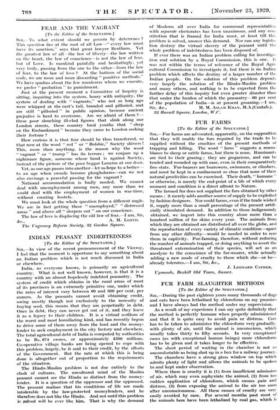FUR FARMS [To the Editor of the SPECTATOR.] SIR,—Fur farms
are advocated, apparently, on the supposition that they will enable the furs required by the trade to be supplied without the cruelties of the present methods of trapping and killing. The word " farm " suggests a resem- blance to sheep or cattle farms, but there is none. Ruminants are tied to their grazing ; they are gregarious, and can be tended and rounded up with ease, even in their comparatively free state. -Fur-bearers are burrowers, swimmers, or climbers, and must be kept in a confinement so close that none of their natural proclivities can be exercised. Their death, " humane " or otherwise, is merely the end-point of a life of which every moment and condition is a direct affront to Nature.
The farmed fur does not supplant the furs obtained by other means : it merely adds another source of supply to be exploited by fashion designers. Nor could farms, even if the trade wished it, supply more than a small percentage of the present artifi- cially stimulated demand. In addition to those indigenously obtained, we import into this country alone more than a hundred million of fur skins every year. The animals from which they are obtained are distributed all over the globe, and the reproduction of every variety of clinaaticcondition—apart from any other difficulty—would be needed in order to rear them in captivity. Fur-farming, therefore, without _reducing the number of animals trapped, or doing anything to avert the threatened extermination of their species, will act as an anodyne to the conscience of the fur-wearer, while actually adding a new mode of cruelty to those which she—or he— already tolerates.—I am, Sir, &c.,






























































 Previous page
Previous page